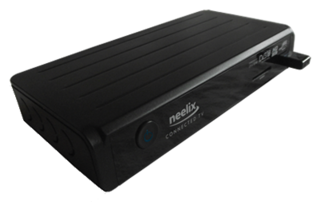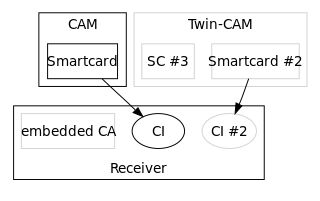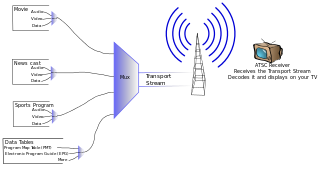
Analog television is the original television technology that uses analog signals to transmit video and audio. In an analog television broadcast, the brightness, colors and sound are represented by amplitude, phase and frequency of an analog signal.

Cable television is a system of delivering television programming to consumers via radio frequency (RF) signals transmitted through coaxial cables, or in more recent systems, light pulses through fibre-optic cables. This contrasts with broadcast television, in which the television signal is transmitted over-the-air by radio waves and received by a television antenna attached to the television; or satellite television, in which the television signal is transmitted over-the-air by radio waves from a communications satellite orbiting the Earth, and received by a satellite dish antenna on the roof. FM radio programming, high-speed Internet, telephone services, and similar non-television services may also be provided through these cables. Analog television was standard in the 20th century, but since the 2000s, cable systems have been upgraded to digital cable operation.

Digital television (DTV) is the transmission of television signals using digital encoding, in contrast to the earlier analog television technology which used analog signals. At the time of its development it was considered an innovative advancement and represented the first significant evolution in television technology since color television in the 1950s. Modern digital television is transmitted in high-definition television (HDTV) with greater resolution than analog TV. It typically uses a widescreen aspect ratio in contrast to the narrower format of analog TV. It makes more economical use of scarce radio spectrum space; it can transmit up to seven channels in the same bandwidth as a single analog channel, and provides many new features that analog television cannot. A transition from analog to digital broadcasting began around 2000. Different digital television broadcasting standards have been adopted in different parts of the world; below are the more widely used standards:

A set-top box (STB), also colloquially known as a cable box and historically television decoder, is an information appliance device that generally contains a TV-tuner input and displays output to a television set and an external source of signal, turning the source signal into content in a form that can then be displayed on the television screen or other display device. They are used in cable television, satellite television, and over-the-air television systems as well as other uses.

Freeview is the United Kingdom's sole digital terrestrial television platform. It is operated by DTV Services Ltd, a joint venture between the BBC, ITV, Channel 4 and Sky. It was launched on 30 October 2002, taking over the licence from ITV Digital which collapsed that year. The service provides consumer access via an aerial to the seven DTT multiplexes covering the United Kingdom. As of July 2020, it has 85 TV channels, 26 digital radio channels, 10 HD channels, six text services, 11 streamed channels, and one interactive channel.
A satellite modem or satmodem is a modem used to establish data transfers using a communications satellite as a relay. A satellite modem's main function is to transform an input bitstream to a radio signal and vice versa.
A digital video recorder (DVR) is an electronic device that records video in a digital format to a disk drive, USB flash drive, SD memory card, SSD or other local or networked mass storage device. The term includes set-top boxes with direct to disk recording, portable media players and TV gateways with recording capability, and digital camcorders. Personal computers are often connected to video capture devices and used as DVRs; in such cases the application software used to record video is an integral part of the DVR. Many DVRs are classified as consumer electronic devices; such devices may alternatively be referred to as personal video recorders (PVRs), particularly in Canada. Similar small devices with built-in displays and SSD support may be used for professional film or video production, as these recorders often do not have the limitations that built-in recorders in cameras have, offering wider codec support, the removal of recording time limitations and higher bitrates.

A TV tuner card is a kind of television tuner that allows television signals to be received by a computer. Most TV tuners also function as video capture cards, allowing them to record television programs onto a hard disk much like the digital video recorder (DVR) does.

A tuner is a subsystem that receives radio frequency (RF) transmissions, such as FM broadcasting, and converts the selected carrier frequency and its associated bandwidth into a fixed frequency that is suitable for further processing, usually because a lower frequency is used on the output. Broadcast FM/AM transmissions usually feed this intermediate frequency (IF) directly into a demodulator that converts the radio signal into audio-frequency signals that can be fed into an amplifier to drive a loudspeaker.
Television encryption, often referred to as scrambling, is encryption used to control access to pay television services, usually cable, satellite, or Internet Protocol television (IPTV) services.

In Digital Video Broadcasting, the Common Interface is a technology which allows decryption of pay TV channels. Pay TV stations want to choose which encryption method to use. The Common Interface allows TV manufacturers to support many different pay TV stations, by allowing to plug in exchangeable conditional-access modules (CAM) for various encryption schemes.
QAM is a digital television standard using quadrature amplitude modulation. It is the format by which digital cable channels are encoded and transmitted via cable television providers. QAM is used in a variety of communications systems such as Dial-up modems and WiFi. In cable systems, a QAM tuner is linked to the cable in a manner that is equivalent to an ATSC tuner which is required to receive over-the-air (OTA) digital channels broadcast by local television stations when attached to an antenna. Most new HDTV digital televisions support both of these standards. QAM uses the same 6 MHz bandwidth as ATSC, using a standard known as ITU-T Recommendation J.83 Annex B ("J.83b").

An ATSCtuner, often called an ATSC receiver or HDTV tuner, is a type of television tuner that allows reception of digital television (DTV) television channels that use ATSC standards, as transmitted by television stations in North America, parts of Central America, and South Korea. Such tuners are usually integrated into a television set, VCR, digital video recorder (DVR), or set-top box which provides audio/video output connectors of various types.
In television technology, Active Format Description (AFD) is a standard set of codes that can be sent in the MPEG video stream or in the baseband SDI video signal that carries information about their aspect ratio and other active picture characteristics. It has been used by television broadcasters to enable both 4:3 and 16:9 television sets to optimally present pictures transmitted in either format. It has also been used by broadcasters to dynamically control how down-conversion equipment formats widescreen 16:9 pictures for 4:3 displays.
TiVo digital video recorders encompass a number of digital video recorder (DVR) models that TiVo Corporation designed. Features may vary, but a common feature is that all of the units listed here require TiVo service and use its operating system.

A digital television adapter (DTA), commonly known as a converter box or decoder box, is a television tuner that receives a digital television (DTV) transmission, and converts the digital signal into an analog signal that can be received and displayed on an analog television set. Some also have an HDMI output since some TVs with HDMI do not have a digital tuner. The input digital signal may be over-the-air terrestrial television signals received by a television antenna, or signals from a digital cable system. It normally does not refer to satellite TV, which has always required a set-top box either to operate the big satellite dish, or to be the integrated receiver/decoder (IRD) in the case of direct-broadcast satellites (DBS).

A free-to-air or FTA Receiver is a satellite television receiver designed to receive unencrypted broadcasts. Modern decoders are typically compliant with the MPEG-2/DVB-S and more recently the MPEG-4/DVB-S2 standard for digital television, while older FTA receivers relied on analog satellite transmissions which have declined rapidly in recent years.
Interactive television standards are standards for television broadcasting that relate to different modes of interaction and feedback mechanisms. This interaction system is what creates the television experience.
Addressability is the ability of a digital device to individually respond to a message sent to many similar devices. Examples include pagers, mobile phones and set-top boxes for pay TV. Computer networks are also addressable, such as via the MAC address on Ethernet network cards, and similar networking protocols like Bluetooth. This allows data to be sent in cases where it is impractical to control exactly where or to which devices the message is physically sent.
Analog passthrough is a feature found on some digital-to-analog television converter boxes. Boxes without analog passthrough only allow digital TV to be viewed on older, analog-only TVs. Those with analog passthrough allow both digital and analog television to be viewed on older TVs.











